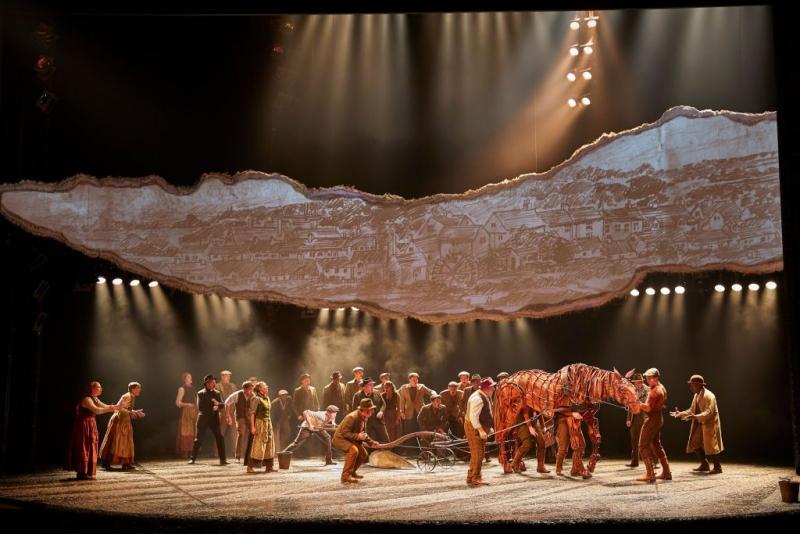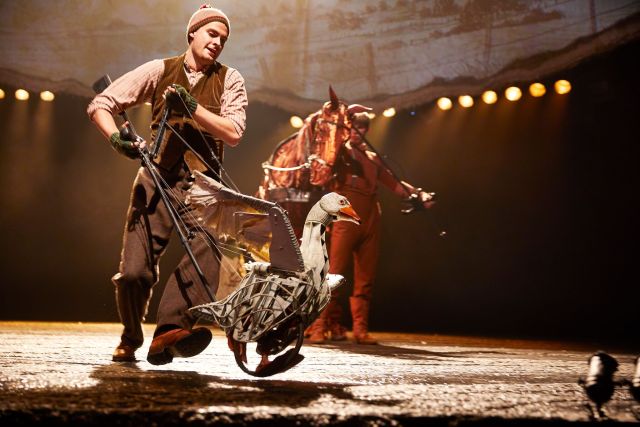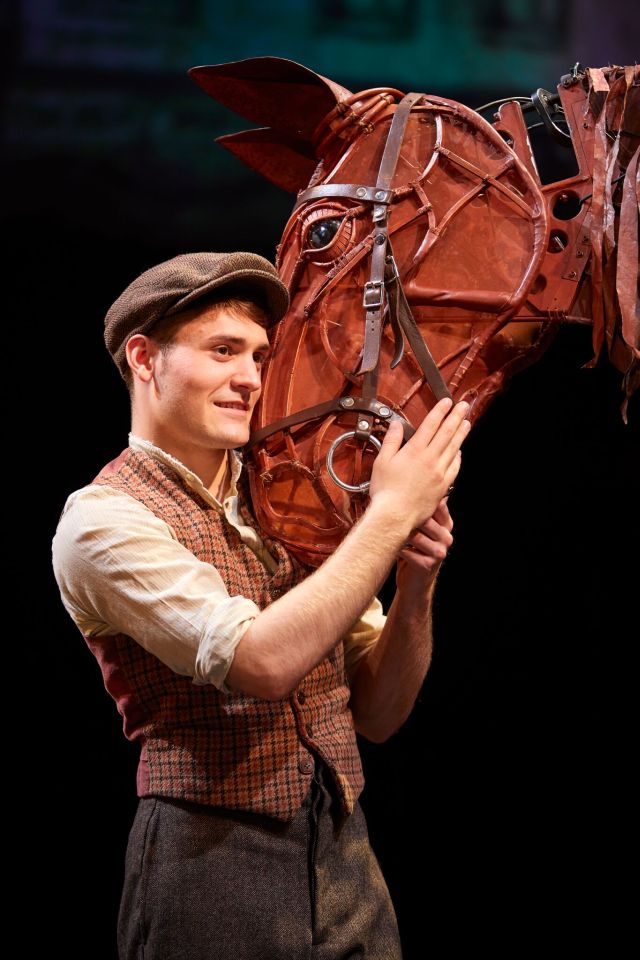War Horse, National Theatre review - still touching after all these years | reviews, news & interviews
War Horse, National Theatre review - still touching after all these years
War Horse, National Theatre review - still touching after all these years
International sensation stirs the heart anew in its return home

War Horse at the National Theatre on Sunday’s Armistice Day centenary: there were medalled veterans and at least one priest in the rows in front, dark suits and poppies all around, and scarcely a youngster in sight.
For anyone not among the some seven million people in 11 countries who have seen the playwright Nick Stafford’s stage version, or the millions more who know the 2011 Steven Spielberg film, War Horse is based on Murpurgo’s children’s novel about the Devonshire boy Albert Narracott and his beloved horse, Joey. They grow up together, and after Joey is sold off as a cavalry horse at the start of World War I, Albert goes to France, with the dreamer’s goal of getting him back. The second major equine character is Topthorn, a magnificent black charger. The action, led by the horses, reaches the German lines and occupied France.  It is safe to say that from the beginning of a theatrical run that included five Tony Awards on Broadway in 2011, it has been the puppets, from South Africa’s Handspring company, and their choreography, that have stolen the show. In the cast list, the horses come first. One early thrill comes when the foal Joey gives way to the magnificent adult rearing up behind him, manned by three puppeteers. Equally, when these masterful puppeteers step away from the frame of a dying horse, it as if they are leaving like spirits. There’s an intimidating hand-carried WWI tank, and of course The Goose, played deliciously here by Billy Irving (pictured above). In my book this wheeled comical honker deserves a spin-off show all of his own (War Goose?).
It is safe to say that from the beginning of a theatrical run that included five Tony Awards on Broadway in 2011, it has been the puppets, from South Africa’s Handspring company, and their choreography, that have stolen the show. In the cast list, the horses come first. One early thrill comes when the foal Joey gives way to the magnificent adult rearing up behind him, manned by three puppeteers. Equally, when these masterful puppeteers step away from the frame of a dying horse, it as if they are leaving like spirits. There’s an intimidating hand-carried WWI tank, and of course The Goose, played deliciously here by Billy Irving (pictured above). In my book this wheeled comical honker deserves a spin-off show all of his own (War Goose?).
War Horse is a bit of a franchise now, with its own range of merchandise. It started out in the Olivier, co-directed by Marianne Elliott and Tom Morris to utilise that auditorium’s drum revolve that rises out of the stage, and the play has returned this time to the Lyttelton with an adaptable set. The first version used original languages, with the Germans speaking German, now dropped in favour of an all-English script.

The characters and dialogue stitched around the impressive beasts are at times frustratingly mediocre. The early scenes, nominally set in the Devon countryside, have a pantomimic quality, as if we’re in the land of Jack and the Beanstalk. One looks for greater depth from young Albert (Thomas Dennis, pictured right), so as to deliver on his relationship with Joey, though the tear-jerking climax remains intact. It’s a different story with Peter Becker, as Friedrich Muller, the German officer and horseman; his bonding with the horses is mature and sure, and they acquire character in his company. Gwilym Lloyd shows wonderful physicality as Albert’s father Ted, both dissolute and ineffectual. Jason Furnival’s Sergeant Thunder is solid as a rock, while Jasper William Cartwright is touching as Billy Narracott, the callous casualty. Rae Smith’s poignant drawings, based on the idea of a wartime’s officer’s sketches, are projected overhead on a ragged stretch of white; they can also be seen in a display case outside.
I came to War Horse from my own simple highlight of the Armistice Day centenary: a talk at a local church from a veteran of Afghanistan - a Lieutenant Colonel and military doctor. In uniform, with full medals, he read his observational poem about a medical team receiving a triple amputee helicoptered in from the front, pumping his body full of blood as they fought to find a heartbeat. From there he talked of his current work with dementia patients, who tragically lose the assembly of memories – the remembrance – that makes us human.
To come to War Horse directly following felt like the very reverse of quiet reflection on the war to end all wars. The battlefront scenes are interrupted by frequent, brutal blasts of cacophonous sound and light, and one begins to dread them. On Remembrance Day, the scenes of the men in uniform, singing as they cross the Channel, had particular resonance. But when the horse Joey is snared in the barbed wire, in the midst of No Man’s Land, the animal’s cry becomes a cry for all.
rating
Explore topics
Share this article
The future of Arts Journalism
You can stop theartsdesk.com closing!
We urgently need financing to survive. Our fundraising drive has thus far raised £49,000 but we need to reach £100,000 or we will be forced to close. Please contribute here: https://gofund.me/c3f6033d
And if you can forward this information to anyone who might assist, we’d be grateful.

Subscribe to theartsdesk.com
Thank you for continuing to read our work on theartsdesk.com. For unlimited access to every article in its entirety, including our archive of more than 15,000 pieces, we're asking for £5 per month or £40 per year. We feel it's a very good deal, and hope you do too.
To take a subscription now simply click here.
And if you're looking for that extra gift for a friend or family member, why not treat them to a theartsdesk.com gift subscription?
more Theatre
 Troilus and Cressida, Globe Theatre review - a 'problem play' with added problems
Raucous and carnivalesque, but also ugly and incomprehensible
Troilus and Cressida, Globe Theatre review - a 'problem play' with added problems
Raucous and carnivalesque, but also ugly and incomprehensible
 Clarkston, Trafalgar Theatre review - two lads on a road to nowhere
Netflix star, Joe Locke, is the selling point of a production that needs one
Clarkston, Trafalgar Theatre review - two lads on a road to nowhere
Netflix star, Joe Locke, is the selling point of a production that needs one
 Ghost Stories, Peacock Theatre review - spirited staging but short on scares
Impressive spectacle saves an ageing show in an unsuitable venue
Ghost Stories, Peacock Theatre review - spirited staging but short on scares
Impressive spectacle saves an ageing show in an unsuitable venue
 Hamlet, National Theatre review - turning tragedy to comedy is no joke
Hiran Abeyeskera’s childlike prince falls flat in a mixed production
Hamlet, National Theatre review - turning tragedy to comedy is no joke
Hiran Abeyeskera’s childlike prince falls flat in a mixed production
 Rohtko, Barbican review - postmodern meditation on fake and authentic art is less than the sum of its parts
Łukasz Twarkowski's production dazzles without illuminating
Rohtko, Barbican review - postmodern meditation on fake and authentic art is less than the sum of its parts
Łukasz Twarkowski's production dazzles without illuminating
 Lee, Park Theatre review - Lee Krasner looks back on her life as an artist
Informative and interesting, the play's format limits its potential
Lee, Park Theatre review - Lee Krasner looks back on her life as an artist
Informative and interesting, the play's format limits its potential
 Measure for Measure, RSC, Stratford review - 'problem play' has no problem with relevance
Shakespeare, in this adaptation, is at his most perceptive
Measure for Measure, RSC, Stratford review - 'problem play' has no problem with relevance
Shakespeare, in this adaptation, is at his most perceptive
 The Importance of Being Earnest, Noël Coward Theatre review - dazzling and delightful queer fest
West End transfer of National Theatre hit stars Stephen Fry and Olly Alexander
The Importance of Being Earnest, Noël Coward Theatre review - dazzling and delightful queer fest
West End transfer of National Theatre hit stars Stephen Fry and Olly Alexander
 Get Down Tonight, Charing Cross Theatre review - glitz and hits from the 70s
If you love the songs of KC and the Sunshine Band, Please Do Go!
Get Down Tonight, Charing Cross Theatre review - glitz and hits from the 70s
If you love the songs of KC and the Sunshine Band, Please Do Go!
 Punch, Apollo Theatre review - powerful play about the strength of redemption
James Graham's play transfixes the audience at every stage
Punch, Apollo Theatre review - powerful play about the strength of redemption
James Graham's play transfixes the audience at every stage
 The Billionaire Inside Your Head, Hampstead Theatre review - a map of a man with OCD
Will Lord's promising debut burdens a fine cast with too much dialogue
The Billionaire Inside Your Head, Hampstead Theatre review - a map of a man with OCD
Will Lord's promising debut burdens a fine cast with too much dialogue

Add comment